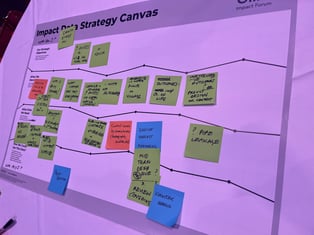Mapping the Future of Impact Reporting: Insights from the GIIN Impact Forum 2025
Walking into the Global Impact Investing Network (GIIN) Forum in Berlin this year, I felt that familiar buzz — that sense that the future of impact investing isn’t being predicted here, it’s being built in real time.
Over two days, I joined conversations that were both urgent and hopeful, especially around how we measure, manage, and report impact. Two sessions stood out: Next Frontiers in Impact Measurement and Impact Data: Needs and Norms. Together, they revealed where the field is heading — and how investors can help shape the next chapter of impact reporting.
1. Focus on What Matters
In Next Frontiers in Impact Measurement, speakers like Kristin Sadler (Quona Capital), Antonia Sariyska (UBS Global Wealth Management), Catherine Macaulay (Schroders), and Shami Nissan (Actis) called for clarity amid complexity.
The message was clear: we don’t need more data points — we need the right ones.
Focusing on a few meaningful metrics that drive decisions is far more valuable than measuring everything.
As one speaker put it, investors should focus on the big needle movers and share what’s working (and what isn’t) to attract more capital into the space.
2. Link Impact and Financial Performance
Catherine Macaulay reminded the group that connecting impact and financial performance remains a challenge — but also one of the biggest opportunities.
The field is maturing, and companies that deliver measurable impact are also showing strong financial outcomes. Rather than being at odds, these two goals can reinforce each other.
To unlock that potential, funders need to actively support investees in gathering and communicating data that demonstrates how doing good and doing well are intrinsically linked.
3. Reimagine Impact Reporting as a Value Creator
Perhaps the most exciting idea to emerge was a call to rethink impact reporting entirely.
Instead of treating it as a compliance task, reporting can become a value creator — a dynamic process that informs decision-making, drives learning, and strengthens the connection between impact and financial performance.
 An interactive exercise asked us to map the current state of IMM, envision the future, and identify enablers and blockers - making it clear that the tools and frameworks exist, we just need the courage to deploy them thoughtfully.
An interactive exercise asked us to map the current state of IMM, envision the future, and identify enablers and blockers - making it clear that the tools and frameworks exist, we just need the courage to deploy them thoughtfully.
Kristin Sadler shared that Quona’s work shows the potential for shared cost models between investors and portfolio companies, where better data benefits everyone.
This is what the next evolution of impact reporting looks like: a tool for learning, accountability, and growth.
👉 Article: SJF Ventures on Impact Measurement as a Strategic Driver of Value
4. Leverage AI Thoughtfully
Artificial intelligence made several cameos throughout the forum. Shami Nissan highlighted AI’s role in simplifying measurement and modeling complex concepts like additionality and counterfactuals.
The takeaway wasn’t about chasing every new tech trend — it was about using technology to make IMM more efficient, accessible, and actionable.
AI can help teams spend less time wrangling data and more time applying insights that drive impact.
5. Balance Standardization with Flexibility
The session on Impact Data: Needs and Norms — featuring Keren Raz (APG), Sugandhi Matta (ABC Impact), and Ryan Clancy (Rally Assets) — dug into the data foundations that make impact decisions possible.
Keren emphasized that large-scale impact requires standardized metrics for comparability, but bespoke metrics at the portfolio level are just as essential to capture nuance.
Sugandhi urged investors to separate data for decision-making from data for monitoring, keeping the focus on what’s truly useful.
And Ryan reminded us that a single, connected data stream — from portfolio company to allocator to asset owner — can finally close the feedback loop and strengthen outcomes across the ecosystem.
6. Close the Feedback Loop
The most powerful idea to emerge was also the simplest: data should flow both ways.
When portfolio companies share insights with investors — and investors share learnings back — everyone gets smarter. This feedback loop transforms data collection from a reporting burden into a cycle of improvement that fuels better products, performance, and impact.
7. Embrace Transparency and Collaboration
Throughout both sessions, there was an undercurrent of honesty and collaboration.
Speakers called for greater transparency, not just about successes but also about failures — because that’s how the field learns and evolves.
As Antonia Sariyska put it: “Be pragmatic, give it a go, and share successes to attract more allocators into this space.”
That spirit — equal parts humility and ambition — captured the energy of the entire Forum.
Looking Ahead
 Leaving Berlin, I felt renewed optimism. The path ahead for impact measurement and reporting isn’t linear, but it’s alive with experimentation, learning, and innovation.
Leaving Berlin, I felt renewed optimism. The path ahead for impact measurement and reporting isn’t linear, but it’s alive with experimentation, learning, and innovation.
By 2030, I hope we’ll see a world where measurement isn’t a reporting exercise, but a dynamic engine for real-world solutions — where investors, companies, and communities learn together.
Because ultimately, impact investing isn’t just about capital. It’s about curiosity, commitment, and the relentless pursuit of better outcomes. And in this moment, the world is counting on us to keep pushing forward.
At UpMetrics, we believe that data should do more than check a box — it should drive learning, collaboration, and action.
If you’re ready to turn your impact data into insights that inspire better decisions and stronger stories, explore how our platform can help.
👉 Learn more about UpMetrics for Impact Investors.
Tags:
Impact Investors
October 21, 2025

